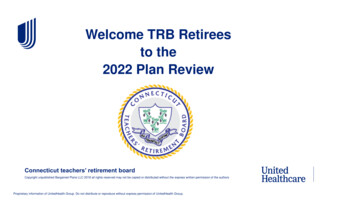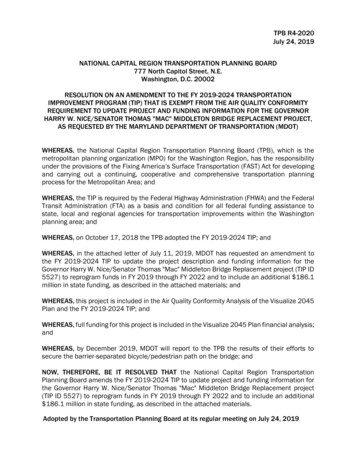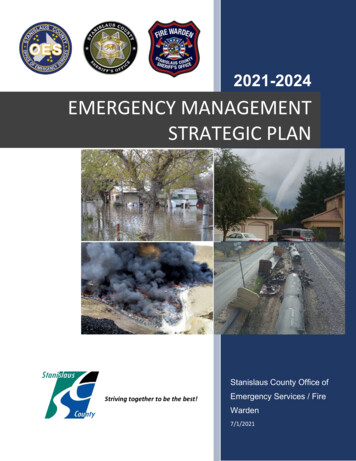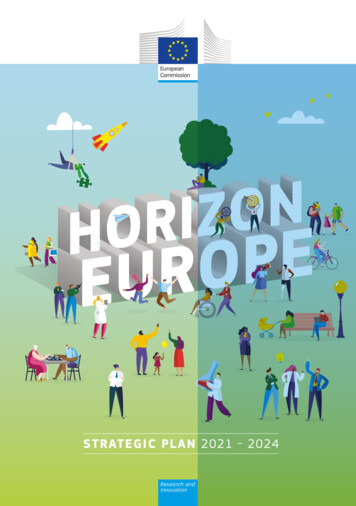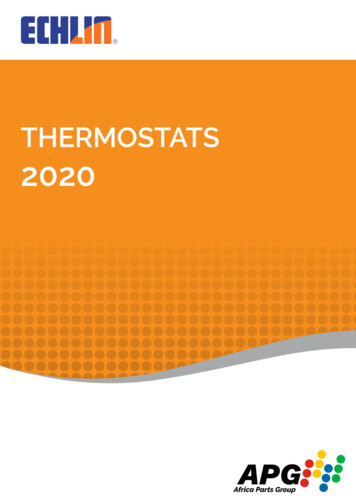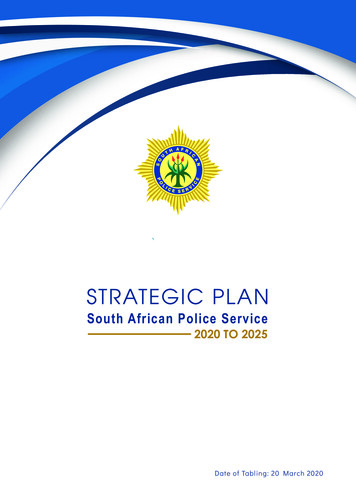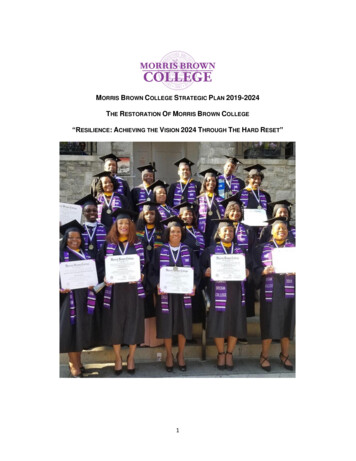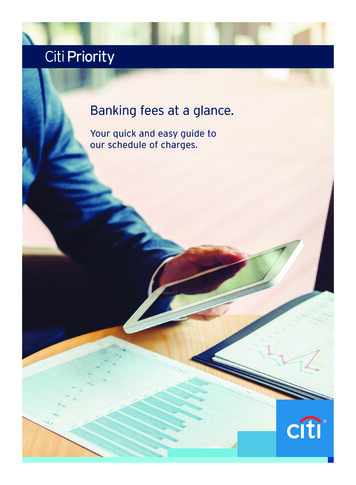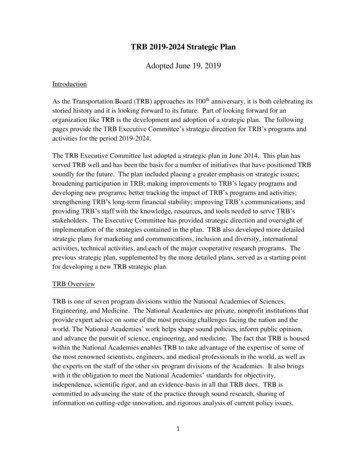
Transcription
TRB 2019-2024 Strategic PlanAdopted June 19, 2019IntroductionAs the Transportation Board (TRB) approaches its 100th anniversary, it is both celebrating itsstoried history and it is looking forward to its future. Part of looking forward for anorganization like TRB is the development and adoption of a strategic plan. The followingpages provide the TRB Executive Committee’s strategic direction for TRB’s programs andactivities for the period 2019-2024.The TRB Executive Committee last adopted a strategic plan in June 2014. This plan hasserved TRB well and has been the basis for a number of initiatives that have positioned TRBsoundly for the future. The plan included placing a greater emphasis on strategic issues;broadening participation in TRB; making improvements to TRB’s legacy programs anddeveloping new programs; better tracking the impact of TRB’s programs and activities;strengthening TRB’s long-term financial stability; improving TRB’s communications; andproviding TRB’s staff with the knowledge, resources, and tools needed to serve TRB’sstakeholders. The Executive Committee has provided strategic direction and oversight ofimplementation of the strategies contained in the plan. TRB also developed more detailedstrategic plans for marketing and communications, inclusion and diversity, internationalactivities, technical activities, and each of the major cooperative research programs. Theprevious strategic plan, supplemented by the more detailed plans, served as a starting pointfor developing a new TRB strategic plan.TRB OverviewTRB is one of seven program divisions within the National Academies of Sciences,Engineering, and Medicine. The National Academies are private, nonprofit institutions thatprovide expert advice on some of the most pressing challenges facing the nation and theworld. The National Academies’ work helps shape sound policies, inform public opinion,and advance the pursuit of science, engineering, and medicine. The fact that TRB is housedwithin the National Academies enables TRB to take advantage of the expertise of some ofthe most renowned scientists, engineers, and medical professionals in the world, as well asthe experts on the staff of the other six program divisions of the Academies. It also bringswith it the obligation to meet the National Academies’ standards for objectivity,independence, scientific rigor, and an evidence-basis in all that TRB does. TRB iscommitted to advancing the state of the practice through sound research, sharing ofinformation on cutting-edge innovation, and rigorous analysis of current policy issues.1
Approximately 8,500 volunteers serve on TRB’s standing technical committees and taskforces, its research panels, its advisory study committees, and the Marine Board. Thesevolunteers are supported by a staff of 146 professionals who are experts in the wide varietyof disciplines involved in transportation. The TRB Executive Committee provides strategicdirection and oversight for all of TRB’s programs and activities. In addition, there areoversight committees for each of TRB’s major program areas.TRB’s major functions are research, convening, and advising. Through TRB’s cooperativeresearch program, TRB manages over 300 research projects at any given time in the areas ofhighways, transit, airports, and behavioral traffic safety. TRB publishes approximately 900peer reviewed research papers per year in its journal the Transportation Research Record andarticles in several additional publications. TRB maintains the largest transportation researchbibliographic database in the world with over 1.2 million records.The TRB Annual Meeting is held each January in Washington DC and is the largestconvening activity of transportation professionals in the world, with over 13,000 attendeesand over 800 sessions and workshops. TRB has 220 standing technical committees and taskforces that convene to discuss current and future issues and research in almost all topicsrelated to transportation. TRB sponsors or co-sponsors approximately 50 conferences orworkshops per year in addition to its annual meeting. TRB delivers over 100 webinars peryear on a wide variety of subjects.TRB conducts a number of consensus studies on a wide variety of policy issues across allmodes of transportation following the rigorous procedures of the National Academy ofSciences, Engineering, and Medicine. These studies often contribute to changes inlegislation or regulation, and in areas such as investment, public/private policy, acquisition,safety, security, and more. In addition, TRB has several standing committees that provideadvice to USDOT modal research programs.National Research Council TransformationThe National Research Council (NRC) is the operating arm of the National Academies. In2017, the President of the National Academy of Sciences, who serves as the Chair of theNRC, asked the National Academy of Public Administration (NAPA) to do a program andprocess review of the NRC. NAPA made a number of recommendations to improve theNRC’s programs and processes. At the same time, the Chair of the NRC asked an externalcommittee to review the NRC’s communications, and this committee issued a report thatmade a number of recommendations for changes to the way the NRC communicates with itvarious audiences. In response to the recommendations from these two reports, the NRCinitiated in 2018 a series of initiatives to make improvements in the areas of products andprocesses, financial management, information technology, human resource management, and2
communications. These initiatives have been going on at the same time as the developmentof the TRB strategic plan and have informed some of the action items contained in this plan.Because the NRC Transformation initiatives will continue after the adoption of this plan,some of the specific actions in the TRB strategic plan may change based on the results of theNRC Transformation initiatives. The Executive Committee felt it was important to go aheadand adopt a new strategic plan at this time, recognizing that some of the actions may changeas a result of the NRC Transformation initiatives.Process for Development of the TRB Strategic PlanThe TRB Executive Committee’s Subcommittee on Planning and Policy Review (SPPR) hasprincipal responsibility for development of TRB’s strategic plan. At its June 2018 meetingthe Executive Committee gave strategic direction to the SPPR to develop a new plan thatwould use the existing strategic plan as a starting point, but would update the plan based onprogress made since adoption of the existing plan, and on changes in circumstances sinceadoption of the current plan. The new plan was to be informed by the issues that would becontained in the Executive Committee’s report Critical issues in Transportation 2019, aswell as the strategies included in specific strategic plans that had been developed formarketing and communications, inclusion and diversity, international activities, technicalactivities, and each of the major cooperative research programs. It was also to be informedby the recommendations of the Executive Committee’s task forces for transformationaltechnologies, resilience, public health, and new revenues; the NRC Transformationinitiatives; the Technical Activities Council Strategic Alignment process; the TransportationResearch Record external peer review, restructuring, and ongoing strategic assessment; theCooperative Research Program business process review; and the TRB Centennial Plan.Finally, TRB staff was requested to perform a SWOT (strengths, weaknesses, opportunities,and threats) analysis to help inform the strategic planning effort. The staff’s SWOT analysiswas completed in fall 2018 and is available on the TRB website.At its October 2018 meeting the SPPR developed draft vision and mission statements, as wellas proposed goals and strategies. These were circulated to all of TRB’s oversight committeesand TRB staff for comments. Outgoing SPPR Chair Daniel Sperling and incoming SPPRChair Katie Turnbull gave an update on the strategic plan process and the draft elements ofthe plan developed to date to the Executive Committee at its January 2019 meeting. Basedon comments received, the SPPR made a number of modifications to the draft, includingchanging the draft strategies to objectives. Working together with staff, the SPPR identifieda draft set of action items under each objective at its April 2019 meeting. After receivingadditional input on its draft plan from Executive Committee members, the SPPR presentedthe draft plan to the Executive Committee for adoption at its June 2019 meeting.3
Next StepsStrategic plans are only effective if the goals, objectives, and action items are implemented.The SPPR will work together with oversight committees from each of TRB’s program areasand TRB staff to identify how the TRB strategic plan will be implemented. This will be donerecognizing that the strategic plan is quite an aggressive plan, containing a very large numberof action items, and is being adopted in a resource-constrained and fiscally uncertainenvironment. USDOT has recently reduced its contribution to TRB’s core technical programby 900,000 per year. The amount of funding for research that will be contained in thestatute that reauthorizes the surface transportation program is uncertain at this time.Therefore, it is likely that not all action items listed in the plan will be able to beimplemented.TRB staff will work with the SPPR to identify the highest priorities and a schedule forimplementation of the action items, together with appropriate performance measures that willbe used to monitor progress. Both the SPPR and Executive Committee will be given regularprogress reports on implementation and which items may need to be deferred due to resourceconstraints.As recommendations are developed through the NRC Transformation process, there willlikely be additions or changes that will need to be made based on what comes out of theNRC-wide initiatives. There will inevitably be additional circumstances that will arise thatwill require changes in priorities or actions contained in the strategic plan. TRB staff willwork together with the SPPR and the Executive Committee to identify appropriate changes.The plan will be a living document that will be adjusted as circumstances warrant over thefive-year life of the plan, or modified based on emerging factors during implementation.The TRB Strategic Plan 2019-2024TRB’s new five-year strategic plan is contained in the following pages. It contains visionand mission statements for TRB, a set of high-level goals, objectives that support the goals,and a series of action items under each objective. It is intended to provide high-levelstrategic direction from the Executive Committee to all of TRB’s programs and committeesand to TRB staff.4
VisionTRB is where the nation’s leaders and the global transportation community turn forinformation exchange, research, innovations, and advice on current, emerging, and criticaltransportation issues to foster a high-performing multimodal transportation system thatenhances society.MissionProvide leadership in transportation improvements and innovation through trusted, timely,impartial, and evidence-based information exchange, research, and advice regarding allmodes of transportation.Goals1. Information Exchange. Provide an impartial forum for the sharing of information acrossall disciplines and modes on current and emerging transportation issues and relatedresearch and innovation, including transportation’s relationship with social, economic,environmental, and other issues important to society.2. Research. Create and expand access to knowledge by conducting, sharing, andpromoting research on current and future issues in transportation, particularly focused oninnovative, implementable practices and technologies.3. Advice. Provide timely and trusted advice to inform the choices facing decision makersacross all modes of transportation.4. Collaboration. Promote collaboration on transportation research, education, andtechnology transfer at international, national, regional, state, and local levels; acrosspublic and private sectors; and among transportation providers, users, and otherstakeholders.5. Workforce Development. Develop transportation professionals by providing lifelonglearning opportunities and by fostering and promoting an environment that continuallyenhances the diversity, inclusivity, skills, and capacity of the transportation professionalcommunity.6. Communications. Enhance the transportation community’s knowledge of TRB activitiesand their impacts, the nation’s leaders’ and public’s awareness of the contributions ofresearch to transportation’s value, and their understanding of the importance oftransportation to society.5
Objectives and Action Items1. Address emerging and critical transportation issues in a strategic, forward looking,proactive, and timely manner.a. Pursue appropriate activities in each program area to address the issues containedin Critical Issues in Transportation 2019.i.Develop and highlight TRB Annual Meeting sessions related to the criticalissues.ii.Pursue sponsorship of conferences/workshops for critical issues.iii.Conduct research projects in critical issues topic areas and disseminate thefindings to key stakeholders.iv.Pursue sponsorship of consensus and advisory studies for critical issues.v.Develop webinars that address critical issue topic areas.vi.Develop Executive Committee policy sessions that address critical issuetopic areas.b. Align the standing technical committee structure to ensure the most importantissues of today and the future are being addressed.c. Identify opportunities for jointly addressing critical issues with other NationalResearch Council program divisions.d. Address critical issues in collaboration with other transportation organizations.e. Refresh the list of critical issues on at least a biennial basis to ensure that TRB isaddressing new and evolving issues.f. Identify and pursue opportunities to address key issues of interest to Congress, theAdministration, states, and local governments in as timely a manner as possible.2. Involve a broad and diverse cross section of stakeholders and constituencies in TRBprograms and activities.a. Identify best practices and develop primers for chairs of committee, panels, andthe Marine Board, and for TRB staff highlighting strategies and resources used torecruit, welcome and actively involve a more diverse committee and panelmembership.b. Find new ways for Annual Meeting and specialty conference attendees to engagein a way that creates avenues for everyone to make connections and feel includedand welcomed.6
c. Develop guidance materials for committee chairs, annual meeting sessionorganizers, and chairs of conference committees regarding recruitment andinclusion of underrepresented groups in their programs and activities.d. Engage with relevant organizations to increase their awareness of andparticipation in TRB, and to solicit their assistance in identifying potentialcommittee and panel members.e. Engage with other domestic and international transportation-related organizationsto identify opportunities for joint activities that are of mutual benefit to both TRBand the partner organization.f. Partner with underrepresented minority-serving organizations (e.g., COMTO,WTS) on professional development activities and in addressing issues of interestto underrepresented groups.g. Expand TRB’s Minority Student Fellows Program and continue to diversifyprogram sponsors.h. Identify target sectors that are currently underrepresented and are important forTRB to have involved in its programs and activities (e.g., new technologycompanies, auto manufacturers, aviation) and work to engage them in TRBactivities.i. Identify and pursue programs, products, activities, and issues of interest to youngand emerging transportation professionals.j. Market TRB’s information resources, including the Transportation ResearchInformation Services (TRIS) program and other digital resources, to youngtransportation professionals.k. Actively market TRB to international transportation professionals.3. Pursue continuous improvements and efficiencies in TRB programs, products, andactivities to increase effectiveness, usefulness, and timeliness.a. Regularly coordinate with TRB sponsor organizations to ensure that TRB isaddressing their priority needs through its programs, products, and activities.b. Complete the Technical Activities Council’s strategic realignment of TRB’scommittees to ensure that the committee structure is aligned with the mostimportant issues for TRB to be addressing.c. Identify and implement ways to streamline and reduce the time required fromproject selection to completion of contract research administered by TRB.d. Identify and implement new ways to provide and promote the value of TRBadvisory studies.7
e. Implement process and product changes that are generated from the NationalResearch Council (NRC) Transformation initiatives.f. Review and make appropriate modifications to TRB business support functions(IT, communications, development, finance, publications) to measure value,increase efficiency, and ensure that TRB is using state-of-the-practice technicaland management methods.g. Review and make appropriate modifications to TRB’s TRIS program to ensurestate-of-the-practice efficiencies are being used.h. Re-engineer the Transportation Research Record to enhance the quality of thepapers, publish more rapidly, and increase the journal’s impact.i. Review and revise conference management processes to improve efficiencies,effectiveness, and financial viability.j. In coordination with NRC Transformation efforts, develop and implementimproved project management tools.k. Continue to identify and implement means to improve the quality, timeliness,reach, and impact of TRB publications and communications.4. Introduce new programs, products, and activities to meet the priorities of TRB sponsorsand stakeholders, taking into consideration resource availability.a. In conjunction with NRC transformation efforts, identify and implementopportunities for new and improved products and services.b. Identify timely methods to address topical issues of interest to sponsors, includingnew sponsors.c. Continue to develop digital products that meet sponsor and stakeholder needs.d. Solicit input from sponsors on their needs and ways that TRB might be able toaddress them, including new ways that are consistent with the NationalAcademies’ mission.e. Pursue sponsors and conduct a workshop on innovative research methods.Explore opportunities to use promising methods.f. Pursue new methods for addressing current research needs, particularly in light ofhow rapidly technology is being developed and deployed, new research methodsare being developed, the increased uncertainty about the future, and the increasednumber of disciplines involved in transportation research.8
5. Systematically identify and track the usefulness and impacts of TRB’s programs,products, and activities, and adjust them to provide the greatest value for the investmentsmade.a. Develop systematic tools for gathering data on and measuring the impacts of eachof TRB’s programs, products, and activities, transitioning from primarilyanecdotal evidence.i.Using data collected by Sage Publications, measure the usage and impactof the Transportation Research Record.ii.Using data collected by the National Academies Press, measure the usageand impact of TRB research reports.iii.Using data collected by the National Academies Press, measure the usageand impact of TRB advisory reports.iv.Collect and report on data collected from TRB sponsors on the impact ofTRB reports five years after issuance of the reports.b. Incorporate recommendations and methods from the NRC Transformationinitiative on measuring the impact of NRC programs into TRB’s impactmeasurement methods.c. Issue annual reports on the usage and impact of each of TRB’s program areas.d. Working with oversight committees for each program area, adjust the program tofocus on areas of greatest value and impact for TRB sponsors and stakeholders.e. Develop value propositions for TRB sponsors and affiliates for each of TRB’sprograms.6. Use means that are effective in reaching diverse audiences to communicate timelyinformation about TRB’ programs, products, and activities, and about transportationissues and policy research.a. Collaborate with other transportation organizations to develop informationalmaterials on the value of transportation to society.i.Conduct research on the most effective means to communicatetransportation’s value to society.b. Enhance TRB’s digital communications capabilities in conjunction with NRC’sTransformation efforts in this area.c. Develop communications strategies for studies, reports, and convening activitiesearly in the planning process for each activity.d. Develop a strategic communications plan for TRB’s program-wide activities.9
e. Track the effectiveness of TRB communications activities through use of the mostappropriate and current analytics capabilities.f. Communicate the value proposition that TRB offers for sponsors and affiliates,including TRB’s objective, independent, non-partisan, evidence-based approachto its programs, products, and activities.g. Review TRB marketing materials to ensure they are appropriate for diverse andkey audiences and adjust as appropriate.h. Develop communications materials for Congressional staff about TRB’scapabilities and value proposition.i. Equip TRB staff and volunteers to be communications ambassadors for TRB’sprograms, products, and activities.j. Adapt TRB’s communications strategies to rapidly changing communicationsmethods.k. Develop a marketing strategy for the TRB Annual Meeting.l. Develop a marketing strategy to target greater awareness of and participation bytransportation professionals and organizations from nations other than the UnitedStates.m. Develop communications strategies that are appropriate for different generationswithin the transportation profession.i.Develop communications strategies that specifically are targeted to youngprofessionals and students.n. Develop and implement an ongoing method to disseminate the results of researchon critical issues topics to federal, state, and local stakeholders.o. Develop articles on the critical issues, research projects, and policy studies forpublications (print, online, video, blogs, etc.) aimed at policymakers, sponsors,and stakeholders.p. Communicate the benefits of standing committee volunteer opportunities toenhance professional development and encourage pathways for diverse groups tobecome actively engaged and take on leadership roles.7. While pursuing additional resources, balance TRB’s programs, products, and activitieswith available financial, volunteer, and staff resources to achieve the goals and objectivesin this strategic plan.a. Annually adjust the amount of activity in each program area to be in balance withthe financial support made available to that TRB program area.10
b. Use information developed on the use and impact of TRB’s programs, products,and activities to make adjustments that ensure that the greatest value is providedfor the resources that are available.c. Evaluate TRB’s Global Affiliate program and Individual Affiliate program toprovide the appropriate balance of benefits to affiliates while increasing revenuesto TRB.d. Evaluate the package of private sector support opportunities for the TRB AnnualMeeting to identify potential improvements for marketing, meeting the needs ofcompanies supporting the meeting, and revenue potential.e. Make TRB’s conferences and workshops self-supporting through sponsorships,exhibit sales, and registration revenues, including potential pool-fundarrangements.f. Identify and pursue additional sponsors, affiliates, and other support opportunitiesfor TRB programs, products, and activities.g. Identify additional organizations that are willing to provide matching funds forCooperative Research Program (CRP) research projects or self-funded TRBconsensus studies.h. Continually evaluate TRB’s programs and activities to ensure that they are beingdelivered as efficiently and effectively as possible.i. Train staff and volunteers to assist in fundraising activities for specific programsand activities.j. Expand TRB’s programs and activities to address new and future transportationissues as opportunities arise, provided financial and staff resources can besecured.k. Identify potential additional TRB professional development offerings, providedthat financial and staff resources can be secured for these offerings.11
TRB 2019-2024 Strategic Plan Adopted June 19, 2019 Introduction As the Transportation Board (TRB) approaches its 100th anniversary, it is both celebrating its storied history and it is looking forward to its future. Part of looking forward for an organization like TRB is the development and adoption of a strategic plan. The following
